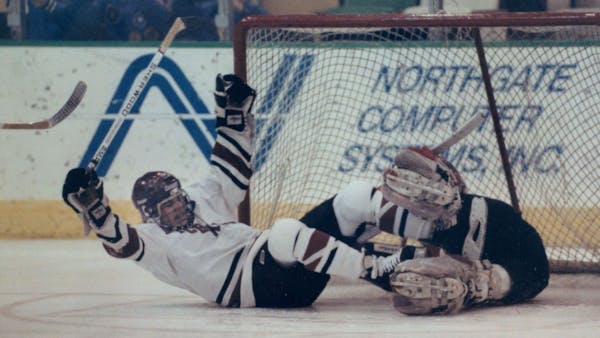Tom Osiecki remembers a high school hockey season, somewhere around the time his Burnsville boys' squad won back-to-back state titles in the mid-1980s, when he had 120 youngsters between grades 10 and 12 try out for the team.
Times have changed.
Burnsville's youth numbers are way down from Osiecki's era, just like they are in the Bloomington Jefferson and Kennedy associations, also one-time state powers. And youth numbers are down even at Eden Prairie and Edina. Richfield, a one-time high school power, folded its boys' program in November.
"You worry about the game in general," Osiecki said. "I think numbers are dropping to a level where it's scary" in some communities.
Minnesota Hockey's overall participation numbers indicate growth — the organization had 17,355 U-8 (8 and under) registrations in the state, an all-time high in the age group hockey officials consider the key barometer of the sport's future health. But while some areas are booming, the overall numbers mask declines in other communities, many of them with a rich hockey history.
First- and second-ring suburbs are now experiencing what the city of Minneapolis has experienced the past two decades, when storied programs at such schools as Roosevelt, Washburn and Southwest crumbled, ultimately leaving the City Conference with a single high school hockey program.
Burnsville, which made five consecutive appearances in the one-class hockey tournament from 1983 through '87, saw its U-8 players go from 120 in 2008-09 to 63 in 2014-15, including only 25 first-year participants; the U-8 and new skater numbers are critical markers for long-term health.
Edina has gone from 376 U-8 players in 2009-10 to 300 last year. Eden Prairie, which has a large immigrant population, had 229 U-8 players in 2009-10 and 130 last season, including a mere 39 first-year skaters. That's a decline from 86 new skaters in 2009-10.
"[U-8 skaters is] a number we watch very closely," said Dave Margenau, president of Minnesota Hockey. "You have to make growth a priority."
Margenau said he's been involved in youth hockey for 40 years and has witnessed declines in once-strong youth programs such as Crystal, Golden Valley and New Hope, and "now it's moving out, to the next ring" of suburbs. Two factors are largely responsible: the influx of diverse populations who were not raised with hockey, and the sport's relatively high cost to play.
"The heart of it is financial," said former Richfield coach Larry Hendrickson, the father of former Wild player and current assistant coach Darby Hendrickson. "In a changing community, like Richfield, most of the kids just can't afford to play."
Derrick Rickey, the marketing and communications director for Minnesota Hockey, said the perception of hockey being an expensive sport "is a big hurdle" that is too often exaggerated. He said the challenge is to get the word out that financial help is available. Minnesota Hockey is attempting to help communities with an ever-expanding list of programs, including Hockey for Free events, equipment and scholarship grants, and a metro recreational league for ages 10 through high school that has 600 participants in its seventh season of existence. There also are several independent organizations working in the cities of Minneapolis and St. Paul, and the Little Wild Program, a partnership between the Wild and Total Hockey that offers a $100 four-week program for 5-year-olds at 12 different sites. The 60 participants at each site are outfitted head to toe.
There have been success stories. St. Louis Park, faced with declining numbers, merged with Southwest Minneapolis, but when numbers continued to decline, St. Louis Park went back to its community-based association several years ago and has been showing signs of growth. St. Louis Park has had at least 40 new 8-and-under skaters in each of the past six years.
Park's story highlights the philosophy of Minnesota Hockey, which is to avoid co-op mergers as long as possible "because eventually it impacts the high school program," Rickey said. "It's important to have enough kids [playing youth hockey] to support the high school program."
Kennedy President Matt Walton said he is using elements of the St. Louis Park model, which relied on a grass roots effort to get young skaters on the ice. Walton said Kennedy is making increased efforts in its diverse communities to get children 6 and younger on skates.
"All the things Richfield battled, we're battling, along with all inner-ring suburbs," Walton said. "We need to make hockey affordable for youth and families that are probably having economic challenges in the first place."
Burnsville coach Janne Kivihalme, in his 10th season, doesn't expect to ever see numbers like Osiecki had. He said high school numbers are like waves — Burnsville had only 38 players try out in 2008 but had 65 this season.
"I'm absolutely optimistic [about the future]," said Kivihalme, a former Burnsville youth coach. "When you have smaller [youth numbers], it's more important for the high school and youth hockey coaches to work together to develop talent."
It's not easy, but Rickey said he has seen communities surviving "through sheer will and hard work" of its coaches and associations. "When demographics change, and you're reaching out to a different group it's more difficult," he said. "But we're getting it done.''
Hyman gets 1st playoff hat trick, McDavid has 5 assists as Oilers beat Kings 7-4 in Game 1

